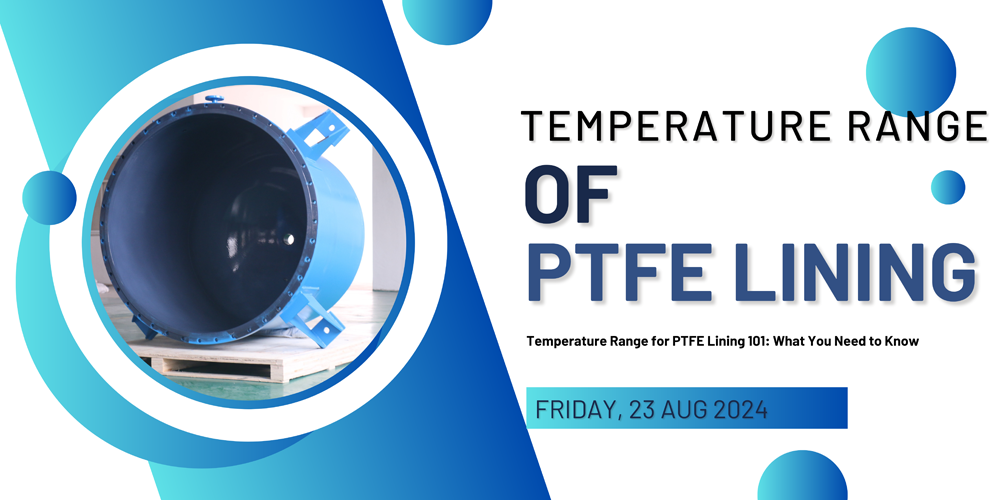
Polytetrafluoroethylene (PTFE) is a versatile material renowned for its exceptional chemical resistance, low friction, and wide operating temperature range. These properties make PTFE an ideal lining material for a variety of industrial applications, particularly where aggressive chemicals and extreme temperatures are involved. Understanding the temperature range within which PTFE lining operates effectively is crucial for ensuring the longevity and performance of the equipment. This article aims to provide a comprehensive guide on the temperature range for PTFE lining, addressing its behavior at various temperatures, factors influencing its performance, and best practices for selecting and maintaining PTFE-lined equipment.
PTFE, commonly known by the brand name Teflon, is a synthetic fluoropolymer of tetrafluoroethylene. It is chemically inert, meaning it does not react with most chemicals, and is known for its extremely low coefficient of friction, making it a popular choice for non-stick coatings. PTFE is composed of carbon and fluorine atoms, creating strong bonds that contribute to its high resistance to heat, chemicals, and electrical insulation. This unique combination of properties makes PTFE an ideal material for lining pipes, tanks, valves, and other equipment used in harsh industrial environments.
PTFE lining is widely used in industries such as chemical processing, oil and gas, pharmaceuticals, and food production. In these industries, equipment is often exposed to corrosive chemicals, high pressures, and extreme temperatures, making PTFE lining essential for protecting equipment from damage and ensuring safe operation. The temperature resistance of PTFE is particularly important in applications where temperature fluctuations or extremes are common, as it prevents the lining from degrading and extends the lifespan of the equipment.
The standard operating temperature range for PTFE lining is typically between -200°C and +260°C (-328°F to +500°F). Within this range, PTFE maintains its structural integrity and chemical resistance, making it suitable for a wide variety of applications. At lower temperatures, PTFE remains flexible and retains its non-stick properties, while at higher temperatures, it does not degrade or lose its chemical resistance, making it ideal for use in environments with high thermal demands.
Several factors can influence the effective temperature range of PTFE lining, including:
Material Purity and Quality: The purity of the PTFE material used in the lining can affect its temperature resistance. High-quality, PTFE typically has a more consistent performance across its temperature range, while filled or modified PTFE may have a reduced temperature range due to the presence of additives or fillers that can affect its thermal stability.
Environmental Factors: The presence of chemicals, pressure, and mechanical stress can all influence how PTFE lining performs at different temperatures. For example, high pressures can cause PTFE to deform, particularly at elevated temperatures, while certain chemicals may accelerate the degradation of the lining at high temperatures.
Thickness and Design of the PTFE Lining: The thickness of the PTFE lining can also impact its temperature range. Thicker linings may provide better insulation and protection at extreme temperatures, but they may also be more prone to mechanical stress and deformation. The design and installation of the lining, including the quality of the bonding between the PTFE and the substrate, can also affect its thermal performance.
PTFE is known for its excellent performance at low temperatures, where many other materials become brittle or lose their effectiveness. At temperatures below -100°C (-148°F), PTFE remains flexible and maintains its chemical resistance and low friction properties. This makes it ideal for use in cryogenic applications, where equipment must operate reliably at extremely low temperatures. In such environments, PTFE-lined pipes and tanks are often used to transport and store liquefied gases, such as nitrogen or oxygen, ensuring that the materials do not react with the lining or cause it to crack.
At high temperatures, PTFE continues to perform well, withstanding temperatures up to +260°C (+500°F) without significant degradation. However, it is important to note that prolonged exposure to temperatures near the upper limit of this range can cause some changes in the material's properties. For example, PTFE may begin to exhibit creep, a slow deformation under sustained stress, especially at high pressures. Additionally, while PTFE itself is thermally stable, its mechanical properties, such as tensile strength and elongation, may decrease at elevated temperatures. This reduction in mechanical strength can lead to issues such as lining detachment or failure if the material is not adequately supported or if it is exposed to mechanical stress.
In environments with rapid temperature fluctuations or extreme conditions, such as cryogenic or superheated environments, PTFE lining must be carefully selected and designed to ensure it can withstand the stresses imposed by these conditions. Rapid temperature changes can cause thermal shock, leading to cracks or delamination of the lining. To mitigate these risks, engineers may opt for thicker PTFE linings or use specialized grades of PTFE designed for high-temperature or cryogenic applications. Additionally, ensuring that the PTFE is properly bonded to the substrate and that the equipment is designed to accommodate thermal expansion can help prevent damage in extreme conditions.
Selecting the right PTFE lining for your application requires a thorough understanding of the temperature conditions the equipment will face. This includes not only the maximum and minimum operating temperatures but also any potential temperature fluctuations, the presence of chemicals or other environmental factors, and the mechanical stresses that may be imposed on the lining. By carefully assessing these factors, you can choose a PTFE lining that will provide reliable performance and protect your equipment from damage.
Several case studies highlight the importance of selecting the appropriate PTFE lining for specific temperature conditions:
Chemical Processing Plant: A chemical processing plant required PTFE-lined pipes to transport highly corrosive chemicals at temperatures up to +200°C (+392°F). The plant chose a high-quality, PTFE lining with a thickness of 3mm to ensure long-term durability. After several years of operation, the PTFE lining showed no signs of degradation, demonstrating the effectiveness of selecting the right material and thickness for the application.
Cryogenic Storage Facility: A cryogenic storage facility needed PTFE-lined tanks to store liquefied gases at temperatures as low as -180°C (-292°F). The facility opted for a specialized grade of PTFE designed for cryogenic applications, which provided excellent flexibility and chemical resistance at low temperatures. The tanks have been in use for over a decade, with no issues related to the PTFE lining.
High-Pressure Steam System: A high-pressure steam system required PTFE-lined valves to operate at temperatures up to +250°C (+482°F) and pressures of 50 bar. The engineers selected a reinforced PTFE lining with improved mechanical properties to withstand the high pressure and temperature. The valves have performed reliably, with no signs of creep or mechanical failure.
These case studies underscore the importance of carefully considering the temperature range and other environmental factors when selecting PTFE lining for critical applications.
Maintaining PTFE-lined equipment within its optimal temperature range is essential for ensuring its longevity and performance. Regular monitoring of the equipment’s operating temperature is crucial, as even slight deviations can lead to premature degradation of the lining. It is important to use temperature sensors and monitoring systems to track the equipment’s temperature in real-time and to set alarms for any readings that exceed the recommended limits.
Temperature-related degradation of PTFE lining can manifest in several ways, including:
Cracking or Crazing: This can occur when PTFE is exposed to temperatures beyond its limits or subjected to rapid temperature fluctuations.
Discoloration: While PTFE is generally resistant to discoloration, exposure to high temperatures over time can cause the material to change color, indicating potential thermal degradation.
Deformation or Sagging: Prolonged exposure to high temperatures can cause PTFE to deform or sag, particularly in areas under mechanical stress.
Identifying these signs early through regular inspections can help prevent more serious issues, such as lining detachment or equipment failure.
To ensure the long-term performance of PTFE-lined equipment, several preventative measures should be implemented:
Adherence to Operating Temperature Limits: Always operate the equipment within the recommended temperature range for the specific PTFE lining used.
Proper Installation: Ensure that the PTFE lining is properly installed and bonded to the substrate to prevent issues such as delamination or detachment.
Regular Inspections: Conduct regular inspections of the PTFE lining, looking for signs of wear, degradation, or damage. Any issues should be addressed promptly to prevent further deterioration.
Scheduled Maintenance: Implement a scheduled maintenance program that includes periodic replacement of the PTFE lining, particularly in high-temperature or high-stress applications.
Understanding the temperature range for PTFE lining is critical for ensuring the safe and reliable operation of equipment in various industrial settings. By selecting the appropriate PTFE lining for the specific temperature conditions, regularly monitoring and maintaining the equipment, and addressing any signs of degradation promptly, you can maximize the lifespan and performance of your PTFE-lined equipment. Whether you are dealing with cryogenic temperatures, high heat, or rapid temperature fluctuations, PTFE offers a reliable solution that, when properly managed, can withstand even the most challenging environments.
Feel free to leave your message on our board. If you're looking to inquire about prices or place an order, this is the right place! Let us know the details of your needs, and our team will get back to you with a personalized quote as quickly as possible. We're here to ensure your experience is seamless and satisfactory. Share your requirements or ask any questions you might have - we're eager to assist and look forward to doing business with you!
Name:Tim
Phone:+86-15716151880
Email:[email protected]
Company:BEANT
Address:No. 28, Luoshen Road, Luoshe Town, Huishan District, Wuxi City, Jiangsu Province
